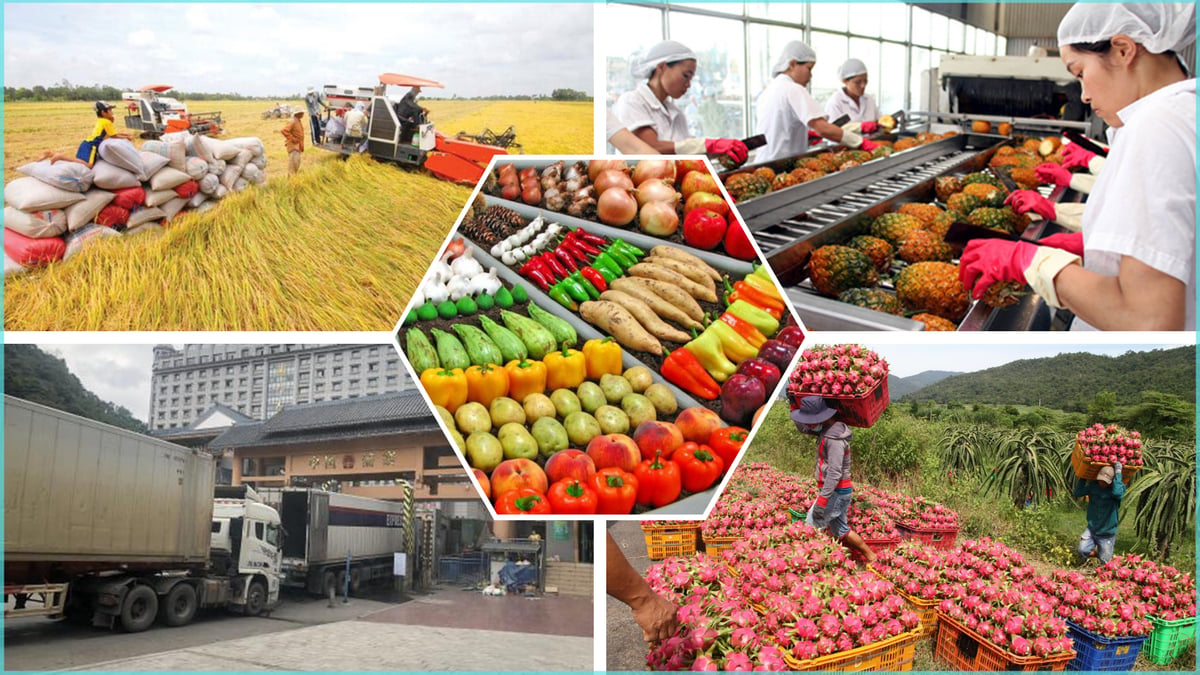November 27, 2025 | 15:44 GMT +7
November 27, 2025 | 15:44 GMT +7
Hotline: 0913.378.918
November 27, 2025 | 15:44 GMT +7
Hotline: 0913.378.918

Agricultural exports in the past 11 months have reached US$ 49.04 billion (up nearly 12% over the same period in 2021).
According to the Ministry of Agriculture and Rural Development, after 11 months, the total import-export turnover of agricultural, forestry and fishery products is about US$ 90.26 billion, up 9.5% over the same period last year. In which, agricultural exports reached about US$ 49.04 billion, up 11.8%; import (import) was about US$ 41.22 billion, up 6.9%; trade surplus of US$ 7.82 billion, up 47.8%.
Thus, the value of agricultural exports in the first 11 months of 2022 has surpassed the record figure of 2021 of US$ 48.6 billion
In November alone, the export turnover of agriculture, forestry, and fishery was estimated at over US$ 4.27 billion, down 4.8% compared to November 2021 and down 0.2% to October 2022. Among them, the main group of agricultural products is US$ 2.13 billion, up 10.3% compared to November 2021; main forest products nearly US$ 1.2 billion, down 15.2%; seafood US$ 750 million, down 17.5% and livestock US$ 31.7 million, down 13.5% …
In the first 11 months of 2022, the leading group of agricultural products exported over US$ 20.73 billion, up 6.6%; main forest products about US$ 15.59 billion, up 8.2%; seafood reached US$ 10.14 billion, up 27%; livestock production $ 361.4 million, down 8.4%; production input is over US$ 2.2 billion, up 38.1%.
Up to now, the agricultural sector has 8 products/product groups with an export value of over US$ 2 billion, including coffee, rubber, rice, vegetables, cashews, shrimp, pangasius, and wood products.
Many items achieved higher export value than in the same period last year, such as coffee over US$ 3.5 billion (up 31.5%); rubber, over US$ 2.9 billion (up 3%); rice over US$ 3.2 billion (up 6.9%); pepper US$ 895 million (up 3.2%); cassava and cassava products over US$ 1.2 billion (up 16.4%), pangasius US$ 2.2 billion (up nearly 62%), shrimp US$ 4.1 billion (up 14.6%), timber and other products wood products US$ 14.6 billion (up 9%)...
Regarding export markets, Asian markets account for 44.7% of the market share, the Americas 27.4%, Europe 11.3%, Oceania 1.7% and Africa 1.7%.
The United States remains the largest export market, reaching US$ 12.3 billion, accounting for 25% of the market share. China ranked second with about US$ 9.3 billion, accounting for 18.9% market share; The third is Japan, with a value of US$ 3.9 billion, accounting for 7.9%...
According to the Ministry of Agriculture and Rural Development, China has not entirely abandoned the "Zero COVID" policy. China's renminbi and Thailand's baht depreciated more than VND and USD, so China tends to import and export more Thai products.
Recently, fresh pomelo (citrus maxima) became the 7th fruit of our country allowed to be imported into the US market after mango, longan, litchi, dragon fruit, rambutan, and breast milk... The result of the long-term negotiation efforts of the specialized agencies between the two sides and the constant companionship of the Vietnamese pomelo producers and exporters community.
The Ministry of Agriculture and Rural Development said that the ministry continued to direct the implementation of the Protocol on durian export and temporary requirements for passion fruit to China; import requirements for pomelos exported to the United States for relevant organizations and individuals in the locality.
In particular, the Ministry soon negotiated technical contents to sign the Protocol on phytosanitary requirements for dragon fruit, longan, litchi, rambutan, and mango exported to China; and coordinated weekly online inspections with the General Administration of Customs of China for bananas and durians. Also, negotiate to remove technical and trade barriers and open official export markets to other large and potential markets such as Japan, Korea, Myanmar, Australia, and New Zealand.
Specialized units work with Japanese plant quarantine inspectors to inspect Vietnamese dragon fruit, mango and longan processing facilities to boost the export of these products.
Towards the goal of total export turnover of agricultural, forestry and fishery products reaching US$ 50 billion this year, the Ministry of Agriculture and Rural Development will continue to accelerate the restructuring of the industry and improve productivity, quality, efficiency of production, business, and direction and orient localities, especially critical areas of rice production, animal husbandry and aquaculture, to have production plans suitable to the market's demand.
In addition to promoting international trade and opening markets, in the domestic market, focus on developing diversified channels of food and food consumption, ensuring supply and stabilizing food and pork prices to help keep the consumer price index (CPI) within the allowable range, especially during the 2023 Lunar New Year.
Translated by Ha Phuc

(VAN) On the morning of November 27 in Beijing, Minister Tran Duc Thang and the Deputy Commissioner General of the General Administration of Customs of China signed a protocol on fresh jackfruit exports.

(VAN) As floodwaters recede, a vast network of irrigation works across eastern Gia Lai is emerging in a state of severe disrepair, with extensive damage demanding urgent restoration ahead of the 2025-2026 winter-spring cropping season.

(VAN) The conference reviewing three years of implementing Decision 911 identified the need to prioritize improving marine environmental quality and promoting sustainable fisheries development.

(VAN) Le Hoai Trung, Member of the Communist Party of Viet Nam Central Committee and Minister of Foreign Affairs, held talks with Vi Thao, Chairman of the Guangxi Zhuang Autonomous Region (China) this week.

(VAN) The Mekong River Commission adopts the 2026 - 2030 Strategic Plan with a people-centered approach.
/2025/11/26/1720-1-200855_132.jpg)
(VAN) Viet Nam and Japan have many conditions to expand cooperation on climate change adaptation, particularly in disaster risk management based on advanced technologies.

(VAN) The strong development of digital technology and artificial intelligence is opening up opportunities to transform science and technology into a 'Magic eye' for disaster forecasting and early warning.